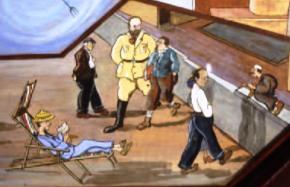Ulysses in prison
Spinelli’s youth was marked by political commitment and his imprisonment by the Fascists. In 1924 he started studying law at University and joined the Communist Party in Rome. He started an eventful activity which continued in a clandestine way under the pseudonym of “Ulysses”. He was arrested in Milan and served 16 years and 8 months in various prisons (Lucca, Viterbo and Civitavecchia) and was interned on Ponza and Ventotene islands. His imprisonment was one of the longest among the antifascists, but he would never give up his own ideas and in prison he completed his formation. In the Thirties he gradually abandoned the Communist ideology, also prompted by Stalin’s cynical policy. In 1937 on Ponza Island he definitively left the Communist Party and a period of deep solitude was ahead of him.
In July 1939 he got on Ventotene island where he stayed until August 1943 (from the age of 32 to 36). Those were important years for him. And it was on the Ventotene Island that Spinelli wrote his Manifesto for a free and united Europe together with Ernesto Rossi and Eugenio Colorni, which was to become known as the Ventotene Manifesto, according to which a European federation was the action priority in the post-war period for all democratic forces. A federal and united Europe was the new political proposal to safeguard peace among European peoples and to defeat any expression of nationalism. Spinelli was faithful to this intuition throughout his life and as a free man he worked hard to accomplish it. A new idea needed a new instrument: that is why Spinelli founded the Movimiento federalista europeo (MFE) in 1943 together with other antifascists. It was an organisation not leaning towards any other political party which will support him in his vanguard battles and is still today a workshop of new ideas and a political arena for many young people.
Not only the prince’s adviser
Between 1943 and 1945 Spinelli worked on “a hypothesis of an impetuous democratic renaissance” hoping for the immediate creation of a European constituent assembly which would found a European federal state. Following the reconstruction of the National States, Spinelli saw the end of a federalist revolution: it was then that he started working on the hypothesis that assigned to the “great moderate European politicians” the task of creating a federal Europe, encouraged in that both by the foreign American policy and the fear of the Soviet influence.
In fact, between 1947 and 1954 a European union seemed inevitable. Spinelli, in the role of a discreet advisor, persuaded De Gasperi to support the project of a European army and the proposal fo a European Defence Community (EDC) on condition that a European political Community is created with a democratic government and a constitutional chart. After the fall of EDC, as a result of the negative vote of the French national Assembly in August 1954, the governments chose the path to the European economic integration ratified by the Rome Treaties in 1957. This is the period when Spinelli became the European political leader able to establish a peer dialogue with heads of States and personalities like Jean Monnet, Paul Henry Spaak, Konrad Adenauer and the president of United States Eisenhower.
Spinelli, who did not want to give up his project of political unity, until 1961 worked on the hypothesis that it was possible to “give an impulse to the widespread feeling for a united Europe” in the societies of the Member States. Town-based Citizens initiatives were started for a census of the Europeans alongside with the elections for the European Congress which were to be based on the model of Gandhi’s Congress of the Indian people, deriving from the peaceful delegitimization of the authority of national governments. Even though those actions were not successful, they have the historical merit of being the first supranational popular consultations.
Out of politics and his return as European Commissioner
In the meantime, in the years of the economic boom, the federalists were asking for the direct election of the European Parliament and for a single currency for the common market, even coining some samples called… “euro”. Between 1961 and 1970 Spinelli almost withdrew from political action, but not from the cultural one. In fact, he kept a teaching post at the John Hopkins University in Bologna and was among the founding partners of the publishing house “Il Mulino” but in particular he studied the working of the European economic Community and its evolutionary potentialities. In the meanwhile, he had become Pietro Nenni’s advisor and was given the chance, because appointed by the Italian government, to return to public life as a European commissioner with the portfolio of industrial affairs. When he was member of the Commission from 1970 to 1976, Altiero Spinelli left durable tracks behind him. Considering the hypothesis of a Commission as an actual government of Europe, Spinelli distinguished himself in proposing an action plan in various sectors of the Community and in adopting courageous choices in his working methods. It suffices to remember that he appointed an Englishman as the head of his Cabinet: his choice was based on competence criteria rather than on nationality ones: this aroused a scandal because the United Kingdom was not part of the Community yet. In industrial matters, the memorandum which was adopted under his leadership is still worth considering. In the same way, he started a common environmental policy and laid the foundations of the common policy for research and technological development. Thus, he showed that he was a “realist visionary”, being capable of pragmatism and vision at the same time, of having ideas and both the juridical and political instruments to achieve them. After his period in the Commission, maybe because tired of the slow legislative process of the Community, Spinelli resumed his militant political life.
The “Spinelli Project”, the final battle
In 1976 he was elected in the Italian Parliament to be then appointed in the European Parliament where he was reconfirmed as a deputy in the first direct elections in 1979. Spinelli, as a member of the Communist group in the Strasbourg hemicycle, got close again to the Communist Party, or, as he had to say, it was the Communist Party that had become “Spinelli-like”, referring to the more favourable attitude of left-wing parties concerning European integration. Actually, he strongly believed that the European project needed the support of people’s masses, hence the writing of his “PCI, what to do? Reflections upon the strategy and objectives of left-wing parties” (Einaudi publisher, 1978).
In his last years, Spinelli worked on a new initiative for a constituent assembly in which the EP would have to play the main role. On February 14, 1984 the Parliament in Strasbourg passed by a large majority a “project of treaty on the European Union”, better known as “Spinelli’s project”. After ECD it was the second effort to give the Community a proper constitution. In spite of the initial support of the French President Francois Mitterand, the governments rejected the project by adopting the Single European Act, which was less ambitious and entirely devoted to the achievement of the internal market. The protagonist of this last battle died on May 22, 1986; his tomb can be found in the Cemetery of Ventotene Island even though his ashes were scattered in the sea, following his explicit will. Anyhow, as before, a lot of innovations in that project were taken into account in the Maastricht treaty, starting from the principle of subsidiarity to the primacy of European right and the acknowledgement of the European Council among the institutions of the Union. All these elements would be then included in the project worked out by the European Convention and, in various ways, inserted in the treaty which is being discussed inside the intergovernmental Convention. Indeed, if we consider the matter more deeply, also the method of the European Convention originates from the opinion, shared and experimented by Spinelli in the EP, according to which governments cannot be the only authors of a constitutional chart.

Today and tomorrow
These are the many faces of a man who together with his partner Ursula Hirschmann represented an example of moral honesty in the Italian and European political world. He was able to take any opportunity offered by historical changes without losing sight of the objective of the European Union: in doing that, he showed qualities of swiftness, precision and clarity.
For Spinelli Europe was the starting point to solve the world’s problems not only the last step to overcome the expressions of nationalism. A Europe closer to the citizens’ needs where they arise, together with the States, builds the foundation for a great supranational democracy. Today Spinelli lives in the memory of the institutions. A building in the European Parliament in Bruxelles bears his name and he is often quoted in the words of the Italian President of Republic, Giorgio Napolitano, who has just collected a few speeches dedicated to him (“Altiero Spinelli and Europe, Il Mulino, 2007) and can be considered his political and intellectual heir.
Also his idea of a united Europe has become popular among Europeans, despite the negative outcome of the referenda in France and the Netherlands the dismissal of a Constitution project by governments. The reasons in favour of a stronger and more democratic Europe in the way shown by Spinelli are still valid as well as the need for a common action in many a sector: from the simple civil European protection which may fight fires, to a common and effective policy concerning economy, social issues, immigration, energy, but the list could be longer including foreign policy, defence, security and antiterrorism.
Today the European Union is made up of elements typical of an international organisation and the characteristics of a complex federal system. It is true, peace has been achieved, but the project is still incomplete and fragile. As shown by the recent resistance by some governments to share their sovereignty in the name of the protection of national interests, thus forgetting that a stronger European union is the only guarantee for the more 27 member states, which would be otherwise alone and defenceless to face global challenges.
We would like to think that after the results of the intergovernmental Conference, a Reform Treaty project will be passed to replace the Constitutional Treaty; the Ventotene federalist would have said, “Maybe it is a step forward, but it is not enough. Let’s start it up again!”, while considering the 2009 European elections and the European citizens to launch again a new constituent initiative.“Dear Altiero – we who didn’t know him could answer – a new generation of young European federalists is ready to go on, happy birthday!”


Follow the comments: |
|
